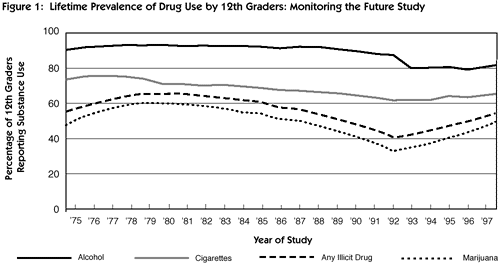|
Rationale Even with the leveling off that occurred in 1997, rates of illicit drug use among youth are still high. Youth, families, and communities suffer significant negative repercussions when young people use alcohol and other drugs. There is a strong association between substance abuse and delinquency, and the prevalence and effects of alcohol and other drug use among youth place additional burdens on the juvenile justice system. Extent of substance abuse among youth The use of alcohol, tobacco, and other drugs by the Nation's youth has been measured since 1975 by the Monitoring the Future study (previously called the High School Senior Survey). Among 12th graders, drug use peaked in 1981, with slightly more than 65 percent of the seniors reporting that they had used an illicit drug sometime in the past. During the following decade, there was a steady decline in the proportion of youth reporting use of illicit drugs during their lives, dropping to a low of 40.7 percent in 1992. Unfortunately, beginning in 1993, this trend reversed; by 1996, 50.8 percent of high school seniors reported using illicit drugs at some time (Institute for Social Research, University of Michigan, 1996). The trends in use of alcohol, tobacco (cigarettes), marijuana, or any illicit drug by 12th graders are shown in figure 1.
 Not only are more youth using mood-altering substances than in the previous decade, they are beginning to ingest them at increasingly younger ages. Figure 2 depicts data from the National Household Survey on Drug Abuse showing an overall decline in the average age of first use of alcohol (from 17.2 years in 1975 to 15.9 years in 1993), daily cigarette use (from 18.6 years in 1975 to 16.8 years in 1994), and especially first use of marijuana (from 18.9 years in 1975 to 16.3 years in 1994).

|